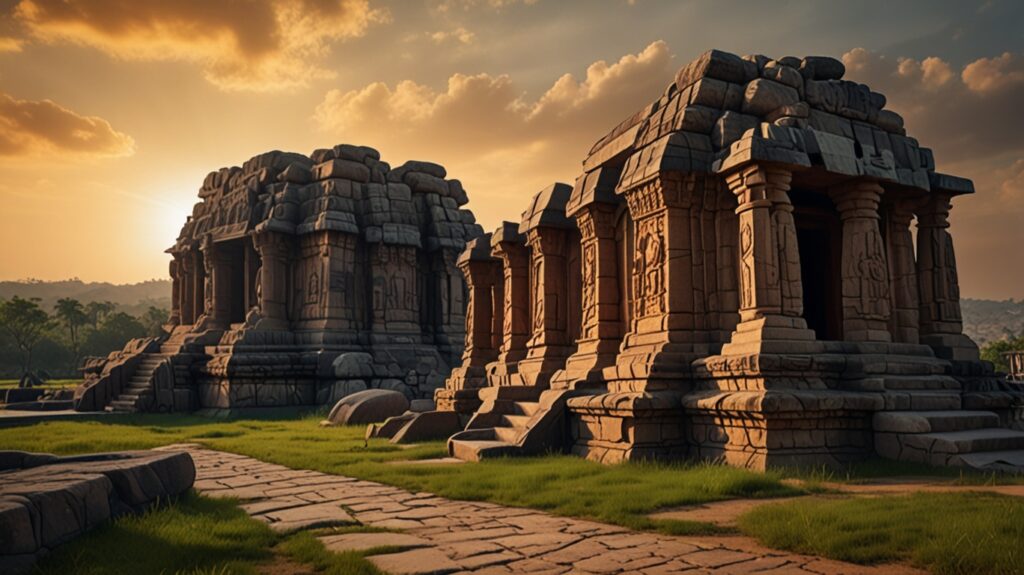The Vijayanagara Empire, founded in the 14th century CE, stands as a remarkable testament to the ingenuity, resilience, and administrative prowess of medieval Indian civilisation. Located in the Deccan region of southern India, this empire flourished through a unique blend of political consolidation, cultural integration, and economic growth, which contributed to its emergence as one of the most powerful and enduring empires in South India. This expanded overview delves into the key aspects of Vijayanagara’s state formation, highlighting the empire’s impact on the socio-political landscape of medieval India.
Foundations and Expansion
The Vijayanagara Empire was established in 1336 by Harihara I and Bukka Raya I, brothers from the Sangama dynasty. Their rise occurred amidst the fragmentation of earlier southern kingdoms, such as the Hoysala and Kakatiya realms, as well as the threat posed by the Delhi Sultanate’s expansion into the Deccan. The founders were initially in the service of the Hoysala rulers and later emerged as leaders of a rebellion to protect Hindu interests from the encroaching Sultanate forces. The capital city of Vijayanagara, located near the Tungabhadra River, became the heart of their kingdom and one of the largest urban centres of its time.
Through a combination of strategic alliances, military conquests, and diplomacy, the empire expanded rapidly. Key territories under their rule included present-day Karnataka, Andhra Pradesh, Telangana, and parts of Tamil Nadu and Kerala. The Vijayanagara kings sought to restore Hindu dominance in South India and revive the region’s cultural and political traditions after the decline of earlier southern powers. At its peak, the empire successfully resisted invasions from the northern Sultanates while consolidating power across vast regions of southern India.
Administrative Structure
The administrative system of the Vijayanagara Empire was highly efficient and centralised, though it incorporated feudal elements for regional governance. The empire was divided into large provinces known as nayankaras or mandalas, each managed by a nayaka (provincial governor), who was appointed by the king. These governors had significant autonomy in their territories, overseeing law enforcement, tax collection, and military recruitment while being expected to remain loyal to the central authority.
At the top of this administrative hierarchy was the monarch, whose rule was considered divinely ordained. The Vijayanagara kings adopted titles such as “Chakravartin” (universal ruler) and “Hindu Suratrana” (protector of Hinduism), reinforcing their role as defenders of dharma and upholders of Hindu civilisation. The king was assisted by a council of ministers, comprising nobles, military leaders, and scholars, who advised on matters of governance, diplomacy, and military strategy.
The feudal system within the empire was reinforced through the granting of amaram (land grants) to loyal vassals and military commanders, who in turn managed local territories and supplied soldiers to the central army. This system helped maintain a balance between central authority and regional autonomy, ensuring stability in the empire’s vast and diverse territories.
Economic Prosperity
The Vijayanagara Empire’s wealth and prosperity were largely rooted in its successful agricultural and commercial enterprises. The fertile plains of the Tungabhadra and Krishna River valleys provided ideal conditions for the cultivation of crops like rice, millet, sugarcane, and cotton, supporting both the domestic population and export markets. The Vijayanagara rulers invested heavily in irrigation infrastructure, constructing canals, reservoirs, and water tanks that ensured a reliable water supply and boosted agricultural output.
The empire’s strategic location on major trade routes connecting the interior Deccan with the Arabian Sea facilitated extensive commerce with Arab, Persian, Chinese, and Southeast Asian traders. The bustling port city of Hampi, the empire’s capital, became a hub of international trade, where goods like spices, precious gems, textiles, and ivory were exchanged. The Vijayanagara rulers imposed taxes on trade and commerce, significantly enriching the royal treasury, which funded the empire’s ambitious architectural projects, religious endowments, and military campaigns.
Cultural Patronage
Under the Vijayanagara rulers, cultural and religious patronage flourished, earning the empire a reputation as a centre of Hindu revivalism. The rulers, particularly Krishnadevaraya (1509–1529 CE), one of the most celebrated kings, supported the construction of grand temples, monuments, and religious institutions. Architectural marvels like the Virupaksha Temple, Vittala Temple, and the Hazara Rama Temple in Hampi display intricate carvings and sculptures that are renowned for their artistic brilliance and grandeur.
The Vijayanagara Court was a vibrant centre of learning and culture, fostering literary traditions in Sanskrit, Kannada, Telugu, and Tamil. Scholars, poets, and philosophers thrived under royal patronage, contributing to the intellectual and cultural life of the empire. Works like Amuktamalyada, authored by Krishnadevaraya in Telugu, and Vidyaranya’s treatises on Hindu philosophy are notable examples of the period’s rich literary output.
In addition to Hinduism, the rulers promoted religious tolerance, supporting Jainism, Buddhism, and even Islam. This inclusive approach helped maintain harmony in a diverse empire with multiple religious and linguistic communities.
Legacy and Decline
The Vijayanagara Empire’s influence and legacy endured long after its decline. Its military resistance to Muslim invasions and efforts to preserve South Indian culture left a profound impact on the region’s history. The empire’s decline began in the mid-16th century, culminating in its decisive defeat at the Battle of Talikota in 1565, when a coalition of Deccan Sultanates overran the Vijayanagara forces. The capital city of Hampi was sacked and destroyed, marking the beginning of the empire’s gradual disintegration.
Despite its downfall, the Vijayanagara Empire’s contributions to Indian civilisation, particularly in the areas of governance, architecture, literature, and religious tolerance, continue to be celebrated. The ruins of Hampi, now a UNESCO World Heritage site, stand as a testament to the grandeur and cultural vitality of this once-great empire.
Conclusion
In conclusion, the Vijayanagara Empire exemplified the power of political consolidation, economic growth, and cultural patronage in medieval Indian state formation. Its rulers not only safeguarded the Deccan from external threats but also nurtured a flourishing cultural and economic landscape that left an indelible mark on South Indian history. Through effective governance, religious tolerance, and architectural achievements, the Vijayanagara Empire continues to inspire admiration and scholarly interest, reflecting India’s rich and diverse heritage.
